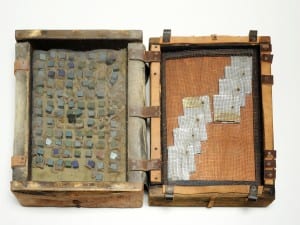Katrina Palmer (b.1967) is a sculptor whose work places great importance on the use of the word. It is an impossibility to escape the central role played by the word in Western culture. Western logocentrism prescribes the rationalism required to unpick what is at first glance, in the case of The Necropolitan Line, an assault on formal reason. The experience of irony when encountering tropes, metaphors and allegories is one that is common upon entering institutions dedicated to endowing them with power. This power is heightened, with the word being lent central importance in this exhibition.
A railway platform bisects the main exhibition space at HMI. Either side of this reminder of the ephemeral in the mundane, the visitor finds the familiar waiting room areas, equipped with floor-affixed, utilitarian chairs. Prior to encountering this example of transition, the visitor encounters illuminated posters of the kind found fixed to the walls of railway stations. The posters themselves comprise photographs of signal points and railway tracks leading to unmarked and uncertain locations. Furthest from the entrance to the galleries at HMI, the visitor finds a heavy goods lift. Every hour and on the hour the doors of the lift are slammed shut and it descends to street level.
Not far from the lift the visitor discovers a pile of newspapers such as one might in a railway station. The newspaper, titled The Line, reprints a Dickens short story: The Signalman (first published in 1866). The reader discovers a tale of how the signalman meets unexpected and uninvited visitors, warning of future catastrophes and disasters as he guides the trains along the right tracks. Further articles by Palmer in The Line provide a formal narrative journey. Cross Bones Graveyard (which closed in 1853), and the Necropolis Railway (which opened a year later) are the departure points here. The shadowy detail of these stories consistently illuminates the abiding fractured narrative of loss, abandonment and discontinuity. We are given to understand that Cross Bones Graveyard is an unconsecrated medieval burial ground for women. It served its local area, which had become by the mid-19th century one of the worst slums in London. Unauthorised disinterment from Cross Bones was a frequent occurrence. Cholera outbreaks and rapid population increases resulted in its closure and the opening of the great London cemeteries.
Fragments of announcements are made over a speaker system in the exhibition space, compounding the impression of being in a railway station. The essential role played by the word, both written and sonic, is the semantic linchpin in an exhibition for which narrative journey – both as the visitor progresses through the exhibition, and in reading The Line – results in a profound and haunting impact.
Daniel Potts
Katrina Palmer, The Necropolitan Line, until 21 February, Henry Moore Institute, Leeds.
Learn more at www.henry-moore.org.
Follow us on Twitter @AestheticaMag for the latest news in contemporary art and culture.
Credits
1. Katrina Palmer, The Necropolitan Line. Photo: Jerry Hardman-Jones





